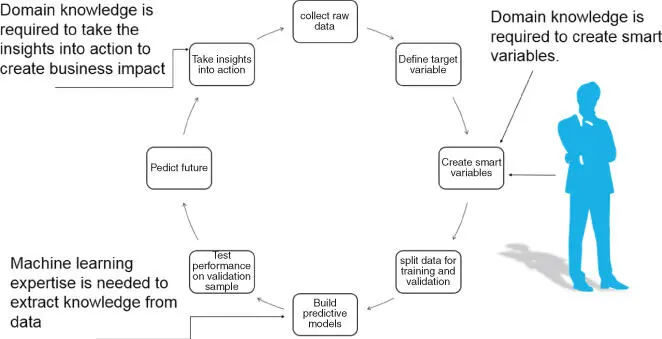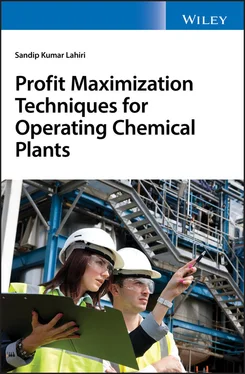Man + machine example: Predictive maintenance in big compressors in the chemical industry. Deep knowledge in the data science field is important in choosing the right machine learning algorithm and in fine tuning models in a way that best predicts machine/component failure in compressors. At the same time, engineering domain knowledge specific to compressors will make a big difference when interpreting and identifying the root causes of failures. Sometimes data collected from other industries running with similar types of compressors can further optimize these models by providing additional ideas for drivers of failures that can be used in the predictive model to further improve the predictive power. Domain knowledge can also help to interpret the results and derive concrete business‐based solutions to prevent failures in the future. Finally, business knowledge is critical in implementing the recommendations, so that processes can be appropriately aligned, e.g. training maintenance engineers to schedule predictive maintenance using the outputs of the predictive maintenance model in their daily work.
1 Step 2: This step involves extracting insights using the machine learning algorithm. The purpose of this step is to select and run the appropriate machine learning algorithm and doing the actual maths and number crunching. The objective is to find the patterns in the data and feature selection. Though a sophisticated AI‐based algorithm is capable of finding all the features in the data, involvement of domain experts during this process helps to generate insights and improve the ability to explain the evolved solutions. Creating new features just helps the machine to find patterns more easily and also helps humans to describe and act on these patterns.
The purpose of this step is to utilize different machine learning algorithms to identify these patterns. Typically, one can distinguish among descriptive analytics (what happened in the past and why?), predictive analytics (what will happen in the future?), and prescriptive analytics (how can we change the future?). In all these steps, simple but also quite sophisticated methods can be used. More and more advanced techniques in AI and machine learning are being used due to the increased amount of available data and computing power. Figure 2.6depicts how data science becomes an iterative process that leverages both human domain expertise and advanced AI‐based machine learning techniques.

Figure 2.6Data science is an iterative process that leverages both human domain expertise and advanced AI‐based machine learning techniques
2.7 From Valuable Data Analytics Results to Achieving Business Impact: The Downstream Activities
The downstream part of the insights value chain is comprised of non‐technical components. It involves people, processes, and business understanding that – through a systematic approach – these new data‐driven insights can be operationalized via an overall strategy and operating model (Holger Hürtgen, 2018).
2.7.1 Turning Insights into Action
Once we have extracted important insights from the models, the next crucial step starts: turning these insights into action in order to generate a business impact. An example would be when a predictive maintenance model gives you warning as to when a compressor or some asset might break down, but maintenance is still required. It is very crucial to understand that just knowing the probability of a breakdown is not sufficient; prevention, not prediction, is the key to business impact. Turning insights into action thus requires two things: first, to understand the insights coming from the data analytics and to know what to do. Second, even once it becomes clear what action needs to be taken, success will depend on when and how that action is taken. This step is very crucial. Knowledge generation by data analytics software is not sufficient; taking corrective and preventive actions from these insights is the key driver for business impact.
2.7.2 Developing Data Culture
The long‐term success of digital transformation requires a company to develop a data culture. This essentially means developing a culture so that all of the business decisions of the company would be based on data analytics and the regular employees of the company would be equipped to implement the data analytics insights into their day‐to‐day actions. A company's internal structure and reward systems should be adopted in such a fashion that promotes the data culture.
2.7.3 Mastering Tasks Concerning Technology and Infrastructure as Well as Organization and Governance
In this step, the organization work process, culture, responsibility hierarchy, governance structure, etc., need to be changed in such a way that will facilitate organizations to take action on the insights from advanced analytics and create an impact. An organization needs the right set of easy‐to‐use tools – e.g. dashboards or recommendation engines – to enable personnel to easily generate business insights and a working environment that facilitates the integration of those insights, e.g. governance that enables and manages the necessary changes within the organization.
1 Holger Hürtgen, N.M. (2018). Achieving business impact with data. Retrieved September 25, 2019, from https://www.mckinsey.com/business-functions/mckinsey-analytics/website: https://www.mckinsey.com/business-functions/mckinsey-analytics/our-insights/achieving-business-impact-with-data.
2 Ji, X., He, G., Xu, J., and Guo, Y. (2016). Study on the mode of intelligent chemical industry based on cyber‐physical system and its implementation. Advances in Engineering Software, 99: 18–26. https://doi.org/10.1016/j.advengsoft.2016.04.010.
3 Klei, A., Moder, M., Stockdale, O., Weihe, U., & Winkler, G. (2017). Digital in chemicals: From technology to impact. Retrieved September 25, 2019, from https://www.mckinsey.com/industries/chemicals/our-insights/website: https://www.mckinsey.com/industries/chemicals/our-insights/digital-in-chemicals-from-technology-to-impact/.
4 Wang, X.Z. (1999). Data Mining and Knowledge Discovery – An Overview. https://doi.org/10.1007/978-1-4471-0421-6_2.
3 Profit Maximization Project (PMP) Implementation Steps
3.1 Implementing a Profit Maximization Project (PMP)
Once a process unit is identified as a potential PMP application, then the following project steps are required to implement the project. These project steps are not written in stone and can be changed and modified as per the needs of individual chemical companies. Various global giant chemical companies have implemented these steps to a varying degree and have sometimes modified the sequence of these steps as per their own strength and business requirements. The project steps are summarized in Figure 3.1.
In the following sections, each of these steps is discussed.
3.1.1 Step 1: Mapping the Whole Plant in Monetary Terms
The aim of a profit maximization project is to maximize the profit generation in dollar per hour terms and sustain the profit at its peak value. Hence the first step of a PMP project is to calculate how much USD/h profit is generating from the plant in every hour on a real‐time basis. As a first step this is done by considering the whole plant as a big black box and mapping it as raw material and utilities as input to the black box and product waste and vent losses as output from the box. The value of each of these inputs and outputs are then calculated as a USD/h term. This gives an overall idea of how much profit is generating from the whole plant. In a second step, a more detailed calculation was done to estimate the USD/h generated or consumed in each major process equipment for the whole plant. Mapping the whole process in USD/h terms makes it easy to view where the actual loss of profit is occurring and to focus on that. This also combines different performance parameters usually used in process industries, like energy efficiency, yield, selectivity, specific consumption of utilities, etc., in a single cost framework and in order to make it easy to visualize the whole process in a single unit of measurements. This will help to access the current operation of the plant and gives an indication of where to focus in order to increase profit.
Читать дальше













